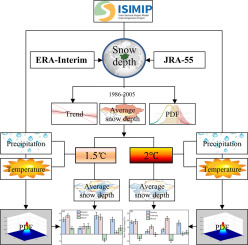Science of the Total Environment ( IF 9.8 ) Pub Date : 2018-10-15 , DOI: 10.1016/j.scitotenv.2018.10.126 Yun Li , Hui Tao , Buda Su , Zbigniew W. Kundzewicz , Tong Jiang

|
Snow depth plays an essential role in the water and energy balance of the land surface. It is of special importance in arid and semi-arid regions of Central Asia. Owing to the limited availability of field observations, the spatial and temporal variations of snow depth are still poorly known. Using the Japanese 55-year (JRA-55) and the ERA-Interim reanalysis snow depth products, we considered four global climate models (GCMs) applied in the Inter-Sectoral Impact Model Intercomparison Project (ISI-MIP), examining how they represent snow depth in Central Asia during the period 1986–2005 in terms of spatial and temporal characteristics. We also investigated changes of winter (January–March) snow depth in Central Asia, at 1.5 °C and 2 °C global warming levels. Finally, the joint probabilistic behavior of winter temperature and precipitation at 1.5 °C and 2 °C global warming are investigated using the kernel density estimator (KDE). The result shows that the snow depth climatology of Central Asia is generally well simulated in both spatial pattern and temporal (inter-annual and inter-seasonal) pattern. All models approximately simulate the winter maximum and the summer minimum values of snow depth but tend to overestimate the amplitude during October–December. Only the trend in HadGEM2-ES matches fairly well to the JRA-55 reanalysis snow depth. When comparing the projections of spatial distribution of winter snow depth, distinctive spatial pattern is noted at both 1.5 °C and 2 °C global warming levels, when the snow depth is shown to increase in northeastern and to decrease in midwestern regions of Central Asia. According to the joint probability distributions of precipitation and temperature, Central Asia will tend to experience a warmer and wetter winter at both 1.5 °C and 2 °C global warming levels, which can be associated with an increase in snow depth in the northeastern regions.
中文翻译:

1.5°C和2°C全球变暖对中亚冬季积雪深度的影响
积雪深度在陆地表面的水和能量平衡中起着至关重要的作用。它在中亚的干旱和半干旱地区特别重要。由于野外观测的有限性,人们对积雪深度的时空变化仍然知之甚少。使用日本的55年(JRA-55)和ERA-Interim重新分析雪深产品,我们考虑了在部门间影响模型比对项目(ISI-MIP)中应用的四个全球气候模型(GCM),就时空特征而言,1986-2005年中亚的积雪深度。我们还研究了1.5°C和2°C全球变暖水平下中亚冬季(1月至3月)的积雪深度的变化。最后,冬季气温与1点降水的联合概率行为。使用内核密度估计器(KDE)研究了5°C和2°C的全球变暖。结果表明,中亚地区的积雪深度气候学在空间格局和时间格局(年际和季节间)上都得到了很好的模拟。所有模型都近似模拟了雪深的冬季最大值和夏季最小值,但往往会高估10月至12月的振幅。仅HadGEM2-ES中的趋势与JRA-55再分析雪深相当吻合。当比较冬季积雪深度的空间分布预测时,在全球变暖水平为1.5°C和2°C时,注意到明显的空间格局,这表明东北亚积雪深度增加,中亚中西部积雪深度减小。


























 京公网安备 11010802027423号
京公网安备 11010802027423号